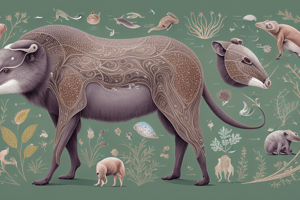Podcast
Questions and Answers
What is the main difference between marsupials and placental mammals?
What is the main difference between marsupials and placental mammals?
- Marsupials give birth to underdeveloped young, while placental mammals give birth to fully developed young. (correct)
- Marsupials have a longer gestation period compared to placental mammals.
- Marsupials are aquatic mammals, while placental mammals are terrestrial.
- Marsupials lay eggs, while placental mammals give live birth.
During fertilization, where does the egg get fertilized in mammals?
During fertilization, where does the egg get fertilized in mammals?
- In the ovaries
- In the fallopian tube (correct)
- In the uterus
- In the placenta
Where does fertilization of a mammal's egg by a sperm take place?
Where does fertilization of a mammal's egg by a sperm take place?
- In the testicles
- Outside the mother's body
- In a pouch or sac
- Inside the female's body (correct)
What is the function of the placenta during mammalian reproduction?
What is the function of the placenta during mammalian reproduction?
How do monotremes differ from other mammals in terms of reproduction?
How do monotremes differ from other mammals in terms of reproduction?
How does the fetus receive nourishment and oxygenated blood during the gestation period?
How does the fetus receive nourishment and oxygenated blood during the gestation period?
What is the role of the ovaries in the female reproductive system?
What is the role of the ovaries in the female reproductive system?
What is the purpose of the three trimesters during gestation in mammals?
What is the purpose of the three trimesters during gestation in mammals?
At what age can some whales, like the bowhead whale, reach sexual maturity?
At what age can some whales, like the bowhead whale, reach sexual maturity?
Which mammal species mentioned has the longest gestation period?
Which mammal species mentioned has the longest gestation period?
What initiates the process of birth in mammals?
What initiates the process of birth in mammals?
What marks the end of the mammalian gestation period?
What marks the end of the mammalian gestation period?
Flashcards are hidden until you start studying
Study Notes
Reproduction and Birth of Mammals
The reproduction and birth of mammals is a complex process that involves various stages and mechanisms. Mammals reproduce sexually, with a few exceptions such as monotremes, which lay eggs. This article will discuss the reproductive processes, including fertilization, gestation, and birth, of mammals.
Fertilization
Mammals undergo internal fertilization, where sperm from the male combines with the egg from the female within the female's body. The egg is released from the female's ovaries, travels through the fallopian tube, and is fertilized in the uterus. The fertilized egg then develops into a fetus, which receives nourishment and oxygenated blood from the mother through the placenta.
Gestation
The gestation period, also known as pregnancy, is the time during which the fetus develops inside the female's body. The length of gestation varies among species. For example, humans have a gestation period of 40 weeks, while blue whales can take up to 11 months. The process of gestation is divided into three trimesters, with the fetus growing and maturing throughout this period. The fetus receives all its nutrients and oxygenated blood from the mother, which can be a taxing process for the mother, requiring her to consume additional calories and other nutrients.
Birth
Once the fetus has developed enough, the mother's body initiates the process of birth. This involves contractions of the uterus and dilation of the cervix, followed by the fetus descending into the birth canal. The fetus is then pushed out of the female's body, and the placenta is expelled shortly after birth.
Maturity and Reproductive Age
The age at which mammals reach sexual maturity and can reproduce varies widely among species. For example, rodents such as Norway lemmings can reach sexual maturity in 1-2 months, while primates like humans can take several years. Some whales, like the bowhead whale, reach maturity at an age of about 23 years.
Marsupials and Placental Mammals
Marsupials are mammals that give birth to underdeveloped young, which then continue to develop outside the mother's body, often in a pouch or sac. Placental mammals, on the other hand, give birth to fully developed young that are nourished by the mother's placenta during gestation.
Reproductive System
The mammalian reproductive system consists of the male and female reproductive organs, which are responsible for producing and transporting the gametes (sperm in the male, egg in the female). The male reproductive system includes the testicles, which produce sperm, and the female reproductive system includes the ovaries, which produce eggs.
Mammalian Reproduction
Mammalian reproduction is a complex process that involves various stages and mechanisms. The fertilization of a mammal's egg by a sperm takes place inside the female's body, and the fetus develops throughout the gestation period, receiving nourishment and oxygenated blood from the mother through the placenta. Birth occurs when the fetus has reached sufficient development and is expelled from the female's body. The age of sexual maturity varies among species, and mammals can be classified into marsupials and placental mammals based on their reproductive strategies.
Studying That Suits You
Use AI to generate personalized quizzes and flashcards to suit your learning preferences.



